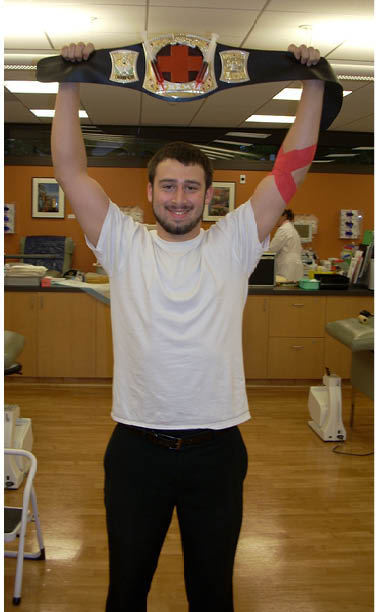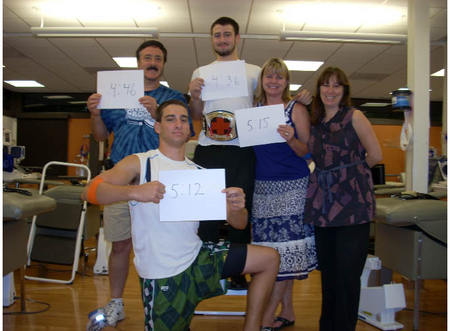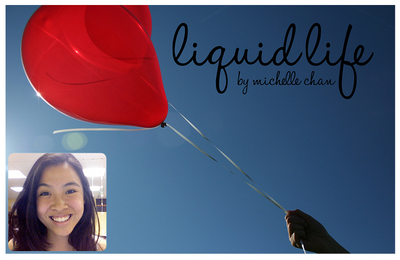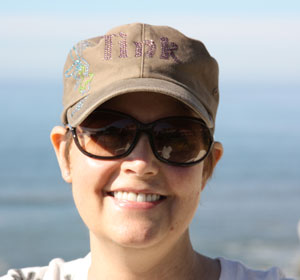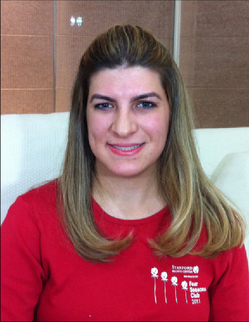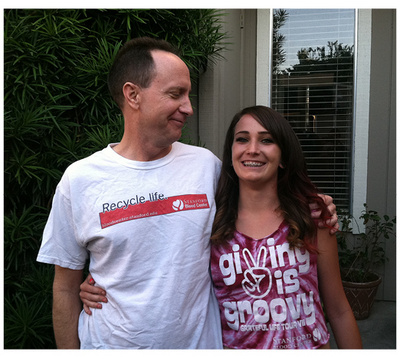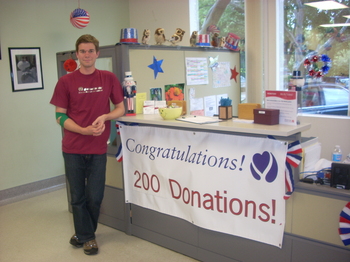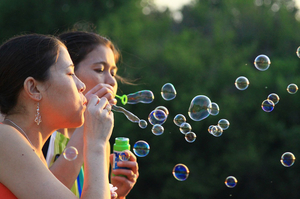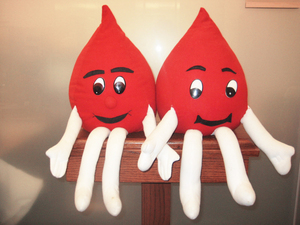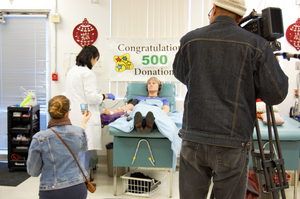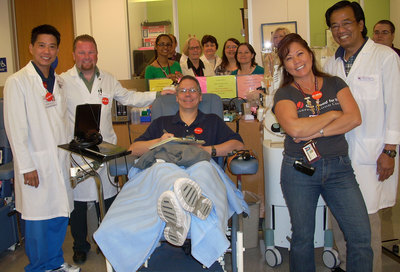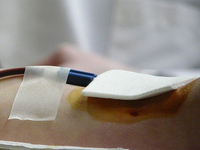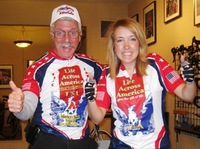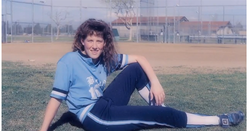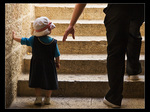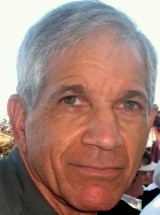Champions
I Am
| Tweet |
By Lauren Ward Larsen, grateful multi-gallon blood recipient and the author of Zuzu's Petals: A True Story of Second Chances
I woke up one Tuesday and knew it was going to be a crappy day. I asked my daughter to get herself ready for school and wake me when it was time for me to drive her there. I e-mailed my personal trainer and cancelled my first appointment to launch a workout routine. Even showering felt like too much effort.
I dragged myself through the day with a general sense of exhaustion, but I hesitated when I was about to cancel my evening plans to attend an advance screening of a new documentary with a friend. I had already cancelled attending her birthday party the week before, so I decided to pull myself together and fake my way through our date. And boy, am I glad I did.
“I Am” is the latest film project of director Tom Shadyac, whose credits include directing Ace Ventura, Bruce Almighty, and Liar Liar. Being a big fan of the “stupid humor” genre of movies, I was curious about the more serious, thought-provoking side of Tom. After a cycling accident left him struggling with both physical and emotional recovery, Tom began to question the value of the many outer trappings of his Hollywood success: the homes, the private jets, all that pricey “stuff.” Was it really what made him happy? Or was he, as he suspected, part of the cancer that infected society?
Tom rid himself of most of his possessions – including his 17,000 sq. ft. Beverly Hills mansion – and moved into a simple neighborhood comprised mostly of trailer homes. Riding his bike to work each day, he launched his latest (and self-funded) project. Setting out with a small film crew, Tom asked an array of significant thinkers two questions: What’s wrong with the world? And what can be done to make things better?
Instead of receiving confirmation about the competitive “dog-eat-dog” nature of life, Tom discovered what was right with it: that we’re genetically predisposed to connect with one another, to feel and display empathy, to cooperate, to be our brother’s keeper. As one scientist he interviewed put it, we are “hard-wired to respond” with compassion when we see someone in need. Another said, “What we do at the individual level really does impact at the global level.”
I couldn’t help but think about blood and organ donors, most of whom have no personal ties to the people whose lives they’re saving. Just like the proverbial butterfly flapping its wings, the blood donor rolls up her sleeve and sends a profound ripple effect into the lives of the patient and his loved ones. Who’s to say what good blood and organ recipients will create in the world once given that second chance? As Tom concludes, love is a force. And being a blood or organ donor is one of the most profound displays of love possible.
Following the movie screening was a question-and-answer session with Tom, during which his irreverence, joy, empathy, and pure humanity poured forth. I didn’t want to put Tom on the spot with my question, so I waited until most of the auditorium had cleared out to approach him, though I already sensed the answer to my question. Not only are he and his movie promoter, Harold, regular blood donors, but Harold also donated a kidney to a complete stranger – an Ethiopian immigrant with whom he continues to stay in touch. Why am I not surprised?
I left the event feeling reconnected to people and reinvigorated about the work I do. Tuesday – as it turned out – was anything but crappy.
Gold-Blooded Family
| Tweet |
By Julie Ruel, Social Media Manager, Stanford Blood Center
When Randy Helmonds, wife Lisa, and their two teenage boys donate blood, they take an unconventional approach. Why sit quietly in the donor chair when it can be so much more exciting? “Creating a friendly, competitive environment is a fun direction to go,” shares Randy who wants blood donation to be something his family looks forward to.
The close-knit family of competitive sports players and routine blood donors enjoy bringing humor into their activities. When they visited SBC last week for their regular appointment, they decided to compete for gold in a new Olympic sport of their own invention. Who could fill the pint-size bag with blood in the least amount of time?
To prepare, older brother Douglas ran around the building several times to get his blood pumping faster. Turns out he’ll need a new coach next time. Just barely avoiding disqualification, he spent several minutes on the sidelines with an elevated pulse. Younger brother Thomas wore compression shorts in an effort to enhance his athletic performance. And the rest of the family relied on good ol’ luck. Rookie move.
As the needles went in, Lisa, the official timekeeper, started the clock. The seconds and minutes ticked by as the players faced their opponents across the room. At minute four, things got intense as Randy and Douglas’s bags neared the finish line. And about a half minute later, we had a champion! Douglas took the gold, leaving dad in second place.
The Helmonds plan to recruit more family members each time they visit and, says Randy, “The competition will continue”. For their next visit, we’re told they have something planned involving referee uniforms, flags, and boxing gloves, staying within the boundaries of the sport of blood donation, of course. (Hint: they’ll be eligible in just under eight weeks, typically donate at our Mountain View Center, and wouldn’t mind some fellow blood donors as spectators!).
Clockwise from bottom: Thomas, Randy, Douglas, sister-in-law Kim, Lisa
Liquid Life
| Tweet |
Michelle Chan is a student at Mountain View High School and Freestyle Academy of Communication Arts & Technology. The following is an excerpt from her book, Liquid Life, which she wrote for a research project at Freestyle Academy.
For as long as I can remember, my dad would come home every couple of months with a pint of ice cream and a bright red bandage around his arm. I was always happy to see the ice cream, as well as my dad, of course. But it wasn't until I was older that I found out why he got the ice cream. As both he and Baskin-Robbins like to call it, it was "A Pint for A Pint". For every pint of blood that my dad donated, he would receive a Baskin Robbins coupon for a pint of ice cream in return.
When we were first asked to choose a topic for the book, I wasn't sure at all what I was going to do. But I finally decided to research the Stanford Blood Center. This topic was introduced by my friend, Paige Topole, who is a volunteer there. During this time I read a book titled Blood by Douglas Starr. The 496-page book was intimidating at first, but I found it to be so full of fascinating information that I was able to use for my book.
I ultimately decided I would document the Stanford Blood Center because I think that its value to the community is often overlooked unless you're a patient receiving blood. Even though my dad is a regular blood donor, I didn't know just how much his donation impacts the community until after I researched it. After a couple of trips to the Mountain View blood center I got the opportunity to shadow Paige (pictured below, donating blood) as she went through the donation process and I learned much about how the center functions.
In a few words to describe my experience there are that the nurses are very nice and it has very delicious cookies. Through interviews with both donors and staff members at the blood center, I was able to find out and appreciate all that it offers to the community.
* * * * * * * * * * * *
Imagine that you were just in a head-on collision and you need surgery right away or you will die. That was the case for seven-year-old Brennah Payne who was left with massive internal abdominal damage, a bowel severed in five places, and a broken spine. Brennah was rushed to Lucile Packard Children's Hospital in Palo Alto for immediate treatment. Over the course of six months, she endured surgery after surgery - 22 procedures - and many transfusions of plasma and red blood cells to repair the damage done by the crash. Without the many, many units of blood, her chances of survival would have been slim. Brennah, now fourteen-years-old, is doing just fine and encourages people everywhere to donate blood. Her mother, Heather, knows just how important blood donors are. "I've been on the other side," she says. "Sometimes you think you're only one person and that one unit of blood won't make a difference, but drop by drop, it all makes a difference. We're so grateful".
Blood donation isn't anything new. In fact, it started back in the 1600s when one of the first recorded donations of blood took place. Soon, hospitals everywhere started utilizing the human resource of blood. A few centuries later, medical scientist Bernard Fantus found that blood was able to be stored. He called it a "blood bank" and that name stuck. The creation of blood banks came just in time as months later World War II occurred. During the war many makeshift blood donation centers were put into operation to support the number of people giving blood. The Red Cross hired a publicity staff to encourage people to donate blood for the war effort. One poster showed a wounded soldier with the caption, "He gave his blood. Will you give yours?" It rallied the people on the home front to do what they could to help the war effort. Douglas Starr, author of Blood, states "…it became clear that they (blood that was transferred to the soldiers) gave soldiers a psychological boost – not only because they increased the men's chances of survival, but because those fighting knew the enemy had virtually none. Even the cosmetic effects of blood proved uplifting: Soldiers who were used to seeing their wounded comrades look death-white, even with plasma, now beheld a rosier glow". Because people had donated blood, the soldiers felt more compelled to fight on. They knew that blood was a powerful weapon that they could use in their advantage. Blood had such a powerful effect on the soldiers and was so very precious.
Albert Einstein said: "The value of a man resides in what he gives and not in what he is capable of receiving." He is right. Giving to others is a good thing to do. During World War II, people from all across America gave their blood to do their part. Even today, blood is still needed. Roughly five million people need blood each year for surgeries or due to illnesses. Unfortunately, only five percent of people who can donate blood actually do. Approximately every two seconds, someone needs blood. That means dozens of people have needed a transfusion since you started to read this article. Blood banks are always in danger of not having enough. Two contributing factors are that donated blood has an expiration date and patients have to receive their own specific blood type. Donating blood is so important and many do it because they want to help others.
So, why should you donate blood? Of course, the most conventional answer is because it saves lives. But if you dig deeper you will see that donating blood isn't just about saving lives, it's about taking part in your community and giving back. It's about the joy you receive from giving. Donating blood has been a big part of the United States' history and there's no reason to stop now.
Click here to see Michelle's complete research project.
A Letter to Blood Donors
| Tweet |
The following letter was written by Michelle Moskalik in August, just three months before she passed away. Her family has been gracious in letting us share this with you.
I am an active 43 year old woman with a strong love for life. I am living with terminal breast cancer and acute leukemia (AML). As a result, I am transfusion dependent and now receive blood and platelets on a weekly basis.
I know I’m low on blood when my energy plummets, I’m unable to walk 5 feet without resting to catch my breath, and I don’t have the energy to do simple daily tasks or things that give me great pleasure (like walking my dog, traveling with my husband, or spending time with friends and family.)
Everything changes immediately when I receive blood. After about 10 minutes into the transfusion I feel the life spark returning. I have energy and vitality and feel like myself again. I often cry a little when I leave the ITA, partly because I am so happy to have my life back (if only for a little while until the next transfusion) but also as a thank you to the donors. I have no words to express how incredibly grateful I am to life saving and life giving donors like you who make such a difference in my life. Your selfless gift is a miracle to me. I am sincerely thankful for your great act of kindness and generosity.
As an aside, because I feel so great after getting blood, my friends think I’ve become a vampire. Further evidence:
• Aversion to sunshine: Hello! Wrinkles!
• Aversion to silver: Gold looks so much better with my skin tone.
• Must be invited into homes: have never tried breaking and entering, so not sure about this one. Not sure how to test this without being arrested.
• Have never been attacked by hot werewolf with 12 pack abs. Sad for me. Maybe I can get my husband to dress up.
To view the original letter, please visit Michelle's website.
Blood Drive Birthday Bash
| Tweet |
By Julie Ruel, Social Media Manager, Stanford Blood Center
At a blood donor recognition event last year, Janet Silberman, a 150-time donor, sat in the audience and listened to Larry Frederick, a retired police officer, thank each and every individual in the room for saving his life. Many years earlier, he experienced a life-threatening event that required immediate blood transfusions. His story could have been terribly tragic. But instead, the blood was available and it saved his life. He now rides his bicycle across the country setting up blood drives and personally thanking the donors.
His inspiration and positivity sparked an idea for Janet. She would be celebrating her 60th birthday the following year – why not set up a blood drive of her own and invite her family and friends to celebrate by giving the gift of life? Besides, they vacationed in Europe the year prior for her husband’s 60th. And does anybody really need two back-to-back vacations?
Planning this blood drive/birthday party served an additional purpose for Janet as well. Since her kids are now grown, she has spare time to devote to volunteer work, something she learned the importance of through her parents. So for 10+ years, her platelet donations were not just a part of her routine, they had become an important part of her life. But because of new regulations, she is now ineligible to continue donating platelets. Instead of letting the sun set on her days with Stanford Blood Center, she has remained involved by switching to whole blood donations and taking on the role of blood donation advocate and promoter. “This blood drive was a way to get people donating platelets in my place and I can still feel like I’m giving back.” Indeed! Folks flooded our Hillview Center that day and her drive brought in over 40 units of blood.
Her efforts haven’t stopped at those 40 units, though. The invitation to her birthday celebration was shared with those near and far. Friends and relatives from Los Angeles to Israel were inspired to visit their local blood centers in support of the birthday girl’s wish. And many of these new blood donors have scheduled repeat visits, pledging to continue giving.
We’re grateful for Janet and those alike who not only make space in their schedule to give blood but space in their hearts to understand the importance. In her words, “I’m 60 years young and love life. I want to give back so others can have a longer, better life.”
Nine Lives: A Blood Donor’s Odyssey Donating Around the South Bay
| Tweet |
By John Williams, Marketing Manager, Stanford Blood Center
Lisa Sanfilippo has donated blood in nine separate locations in the past five years. Such is her passion for continuing to help save lives by finding a Stanford Blood Center (SBC) blood drive or Center location wherever she happens to be when eligible to donate.
Lisa donated her first unit at Saratoga High School in 2007 and was instantly hooked. She says, “I got my donor card in the mail and found out what my blood group is – it was cool.” Coming from a medical family – her grandfather was a pediatrician, grandmother a nurse, and father an endodontist – Lisa is passionate about giving blood as a way of helping others. After her first donation in high school, she was determined to continue donating, which she did, first at our Mountain View Center, then at the following mobile blood drives throughout the South Bay:
Emanuel Lutheran Church - Saratoga
Courtside Club – Los Gatos
Coldwell banker – Los Gatos
Intero Real Estate – Los Gatos
Hewlett Packard – Cupertino
Prospect High School – Saratoga
Congregation Shir Hadash - Los Gatos
Lisa found these blood drive locations by searching on our website. As we conduct many blood drives from South San Francisco to Gilroy, and some in the East Bay, it was easy to find a convenient location when she needed it. Most community drives are open drives, meaning that the general public can make an appointment or simply drop-in. Lisa experienced a wide range of donation sites, including gyms and cafeterias. Blood drives are also held at schools, malls, churches, or other community spaces. She says that her favorite place is the bloodmobile because of the high tech interior, with the screens and machines.
Lisa is now a student in the University of San Francisco Nursing Program. She says that she’s had the opportunity to discuss the nursing profession with SBC nurses: “They have all been so friendly and nice, and I’ve asked them how they got their start in nursing.” Despite her busy schedule, Lisa intends to continue donating. She recently received her Four Seasons T-shirt and she pledges to wear it every time she donates, wherever that may be, which makes her a fine example of the spirit of giving.
Grateful Recipient
| Tweet |
By Dimone Gabler, recipient of blood products & champion of blood donors
I thought people who received blood either had surgery, a transfusion for a particular condition, or had been in a serious accident. I found out there are other reasons one might need blood. A few years ago, I thought I had a bad flu bug. After two to three days of not being able to keep anything down, my husband insisted I go to the doctor. I was so weak I was barely able to stand. After the doctor's examination, he sent me to the emergency room at Good Samaritan Hospital.
My then 7-year-old granddaughter was in the ER with her Grandpa and me during this entire process and the ER staff was absolutely wonderful. They explained everything they were doing to Grandma and assured her that all would be okay and I'd be as good as new in a few days. I'm most grateful that what could have been a very frightening experience for a young child turned into an interesting and educational adventure with Grandma because of the kindness and sensitivity of the ER doctors and nursing staff.
After the ER exam, it was determined I was bleeding internally and would need a blood transfusion. Once recuperated, I requested copies of my hospital report and upon review, found I had been admitted in critical condition and had lost over half my volume of blood. I'm a very lucky lady and most grateful for all those who have generously and courageously given blood to save someone’s life or help someone like myself get better.
You never know if a family member, good friend, or even you yourself may need blood. I’m grateful it was there when I needed it and I hope more people will make the time to donate blood.
Donating Blood Gives Life… And Hope
By Lori Shoemaker, dedicated blood donor as a result of mom's encouragement
I looked at the date of my last plasma/platelet donation: March 7, 2011. It was August now I realized and as I blinked at the date, it seemed impossible to remember what life was like just those few short months ago – there seemed to be such a gaping hole in reality and time. Within weeks of that donation in March, my Mom and I, together with the love of her life Alec, would celebrate her 60th birthday in the Cardiac Intensive Care Unit waiting for her operation to repair a heart valve and to replace 2 artificial ones.
In the months before this, Mom had relied on blood transfusions – her 32-year-old artificial valves were not seated properly in her heart anymore and the metal cages were literally beating up her red blood cells, the ‘blender effect’, as the cardiac surgeon described it. And while blood transfusions were keeping her going, the valve replacement surgery we had talked about as an only-if-necessary option a few years ago was now inevitable. There was hope – 30% chance of survival – far better than the 10-15% given to Mom for her first valve replacement surgery at 28 years of age.
My brother, sister, and I, and in fact the whole family, rallied around Mom to get her in better physical and mental health before the surgery. The morning of the surgery arrived and we went with Mom right to the doors of the operating room unit. And we waited. The surgery lasted more than 14 hours and required even more blood. But she did it – she survived the surgery – but even as we celebrated this, every complication imaginable presented itself. More blood, more platelets were needed.
A few days after Mom’s surgery, Stanford Blood Center called me while I was in the ICU waiting room to say that I was a match for one of Stanford’s patients, and could I come in to donate plasma and platelets. Through tears, I explained why I couldn’t right then but I would as soon as I could. As I walked back to Mom’s room and saw another unit of platelets helping her along, a scene flashed behind her, a group of people, blood donors, who had never met her before and who would never know that fighting for her was the most worthy of causes. But these people had donated their time and blood, giving someone, somewhere, another hour, another day, more hope. It hit me at that moment, perhaps for the first time, that the success of the surgeons and the full medical team together with the best cardiac technology, would have been impossible without blood donors.
This notion did not escape Mom and while she supported cardiac care and research, she told us the best thing we could ever do is to become blood donors. When Mom had her first double valve replacement, my sister and I were 12 and 9 years old and too young to donate. But as soon as we were both of age, a healthy sibling rivalry grew between us to see who could donate the most blood - the blood donation center was careful we didn’t cheat and rush ahead of the schedule! Our brother, who was born just a few hours before Mom’s first valve replacement surgery, has joined in, too, valiantly attempting to donate several times but these have not been easy. He keeps trying, though!
Mom’s story doesn’t end the way we desperately wished. After three weeks of stubbornly beating every imaginable complication after surgery, she just finally got tired and died. Mom’s words, that the best thing we could do is to donate blood, are still with us. Our family made a huge withdrawal this year but we are back donating. The sibling rivalry is still there but it is soft and gentle now. And we know we are giving someone, somewhere, another hour, another day, more hope.
Father & Daughter Bonded by Blood Donation
By Gary Davis, Loyal Stanford Blood Center Donor
My name is Gary Davis and I would like to share my experiences donating blood with my daughter Katie. A little history first.
I had my hip replaced at Stanford Hospital in October 2008. A few months later I got a call from Stanford Blood Center (SBC) asking me if I could donate. I'd actually been interested in donating for years but never had a direct request to get me started. SBC happened to have a mobile truck due in my area the following week so I committed to visiting during my lunch hour. This was my first donation and afterwards, the technician told me my blood type was O- and that I tested negative to the cytomegalovirus (CMV). I'd never heard of CMV and asked a few questions. This was the start of a learning experience for me.
I learned that in an emergency it can take a half hour to type someone’s blood and since O- is the universal blood type, it would be used until a patients blood type could be identified.
I found out about the need for platelets at Stanford Hospital for leukemia patients and pre-mature babies. I became a regular platelet and blood donor and felt good about being able to give something to the community during financially difficult times. All it cost me was a little time and gas. Well worth it considering the constant need for blood supplies.
Last December my 16-year-old daughter came to me asking if she could get her nose pierced. My first instinct was to say no. I'm not partial to piercings and tattoos. But I thought about it a bit. She already had multiple ear piercings and, being 16, I could only stop her for a short while until she'd be able to do it anyway.
Then I had an idea. If she wanted to be poked with a needle, why not have her do it for a good cause? I told her that if she went with me and qualified to give blood, that if she donated twice I would let her get her nose pierced. I researched a bit and found that since her last ear piercing had been last summer she had to be deferred from donating for one year. She agreed pretty easily to my conditions. She was aware of my donations and was curious herself.
On Saturday, June 17, we went in for her first donation. Once there we found out she needed to have a photo ID with her, so we turned around and drove the 20 minutes home, and then back again. We were determined! Her first donation was a bit difficult, it took the technician almost two minutes to find a vein, and Katie was great. She didn't squirm or complain at all.
Afterward we decided to treat ourselves. I had at least one SBC AMC Theatre pass with me, so we went and got a slice of pizza, then to a movie, hung out the rest of the day and had a very nice time together!
We found out she is O- and CMV- but unfortunately her veins are too small for apheresis. Her blood is still very much needed, though! In fact, I got a call a couple of weeks ago from SBC letting me know there were shortages and I let them know that we were planning on donating together again that Saturday.
On 8/27 we went in and Katie did her second donation. The technician found a vein on the first poke with Katie so it was an easier experience for her, even though the first time didn't bother her. This time we went and did a bit of clothes shopping and got lunch together and spent most of the afternoon together. We've agreed that our donation days have become special to us after just two times. We make it a day of sharing time together, a rarity between my work and her school, sports, and friends. We are both looking forward to making it a regular outing. It's our special time together catching up and enjoying each other's company, and just as important, doing something for the community.
Katie will be getting her nose pierced soon, but now she has to wait until field hockey is over. She's been very patient!
Thank you to all of the staff at SBC and the donors. Know that you're all doing something very important!
Inspired By the 9/11 Tragedy: A Young Blood Donor's Journey to 200 Donations
By Amanda Baker, Communications Intern, Stanford Blood Center
Daniel Paepcke first started giving blood in January, 2003. Eight and a half years and 199 donations later, Daniel paid his regular visit to the Campus Center and made his 200th donation. Quite an accomplishment for the young man who at age 27, is one of our youngest donors to reach this milestone.
His interest in donating blood was initially piqued in the wake of 9/11.“My best friend suggested we join the huge crowd of people stampeding toward blood banks on September 12, 2001,” Daniel explained. “We were turned away but decided to come back later, when there were fewer volunteers.” Just over a year later, Daniel made his first donation at age 18.
His delay in returning was partly due to his dislike of needles. “Many people are put off by needles,” he noted. “My friend and I took fifteen months to return after September 11th in part because we were both intimidated by the needle. Our aversion went away after the first couple of donations.” Daniel has been giving (and giving and giving) ever since.
For Daniel, a blood donation is not just a way to save lives; it’s a way to unwind and take a break. “It’s a guilt-free escape from a stressful day,” he said. While whole blood donations are generally finished in about an hour, Daniel’s preferred donation method is Automated Blood Collection (ABC), also called apheresis. Instead of giving one pint of whole blood, as in a regular donation, ABC donors give only the specific components of blood needed for patients that day. These donations are comprised of either platelets, red blood cells, plasma, or certain combinations of these blood components. Platelet donors like Daniel can give platelets up to 24 times a year, and many apheresis donors choose to donate every two weeks.
Because ABC involves separating and returning unneeded blood components back to the donor, the donation process takes a little longer. This extended time period, however, allows donors to sit back, relax, and even watch a movie. Stanford Blood Center provides blankets to keep donors warm and cozy, as well as free wireless Internet and DVD players complete with headsets and full access to our DVD library. It is this relaxation aspect that Daniel credits with keeping his donation appointments so consistent.
Of course, giving back to the community is Daniel’s main incentive. “Blood becomes an unexpected life necessity for so many people,” he remarked. “Blood shortages are a reality, and I don’t want someone I care about to be impacted by that. Our advanced medical facilities are worthless without constant community support.”
Plus, he noted, “Stanford lavishes its donors with top-notch snacks and refreshments. My personal favorites are the decadent cookies delivered fresh from Santa Cruz and the passion orange guava juice (POG). Microwave those cookies for seven seconds, and you won’t want to leave until you’ve scheduled your next donation.”
Thanks, Daniel, for making your 200th donation – and for giving blood 199 times before that!
The Power of Two
By Isabel Stenzel, blood recipient and double lung transplant survivor
Hello Stanford Blood Center donors and friends! My name is Isabel Stenzel Byrnes and I'm a social worker and health educator, currently working for the Lucile Packard Pediatric Weight Control Program. I have a twin sister named Anabel, who is a genetic counselor at Lucile Packard Children’s Hospital. We’d like to share our personal story with you in this blog.
Besides being our places of work, Stanford has special significance for both of us. We both graduated from Stanford University, I got married at Stanford, and actually Stanford Hospital saved both of our lives. Some of you may have even played a role in saving our lives.
Back in 1972, Ana and I were born with cystic fibrosis (CF), a genetic lung disease that affects about 30,000 Americans. At birth, Ana had an intestinal blockage, and required emergency surgery. She received her first blood transfusion at three days of age. Some person out there allowed my twin sister to survive, and to join me in a lifetime of love, joy, and adventure.
CF is a very difficult disease. We developed chronic lung infections by the age of ten, and went in and out of the hospital for intravenous antibiotic “tune-ups.” By the time we were 18 years of age, we had been in the hospital cumulatively about 36 weeks of our lives, each. Also, we had to do respiratory treatments several times a day, every day of our lives, just to keep our airways clear. As twins, we developed a symbiotic relationship and helped each other with these treatments, allowing us to become independent from our parents and leave home for college.
Unfortunately, with each lung infection, our lungs became progressively damaged. One of the worst side effects of severe lung damage is hemoptysis, or the coughing up of blood. The day before my thirtieth birthday, I experienced a massive lung bleed and had a very real out-of-body experience. My dear husband had to witness what the ER staff said “looked like a trauma case.” I believe I coughed up nearly 3 cups of blood, and with limited lung capacity I went into shock and nearly died. I remember waking up on a ventilator in the ICU, and looking up to see bags of red blood dripping into me. I was amazed. Some part of someone else was infusing into me, and I was so grateful. It eased my immense fear, confusion and post-traumatic stress of what had just happened.
The next few months were the toughest times of my life. My lungs continued to bleed despite surgical procedures to block the pulmonary arteries. I was chronically anemic, and received several more transfusions. When one has low lung capacity, it is hard enough to breathe. When one is anemic, and not able to carry the oxygen properly in the blood, it is even more miserable. Each time I received blood, I remember feeling a surge of energy—like I had just been given a hit of caffeine! I felt SO much better—and again remember feeling so grateful for the good Samaritans out there who were helping me survive.
During my own struggles with CF, my sister’s story unfolded. Her lung capacity was always worse than mine. At 28, she had 20% of lung function remaining, and was dependent on an oxygen tank to breathe. She was emaciated and chronically fatigued. Despite tremendous fears, she decided to be listed for a double lung transplant. After 16 months on the waiting list, on June 14, 2000, a compassionate family who faced a tragedy said yes to organ donation, and my sister was saved. Her surgery was nine hours long. Because the CF lungs are so scarred, they adhere to the chest wall and removing them leads to massive amounts of bleeding. Ana received 30 units of blood during her surgery. She survived, and within 12 days, she went home to learn how to breathe again, walk again, and live again. Within 12 months, Ana was swimming, hiking, jogging, volunteering and working almost full-time. It was truly human resurrection--- all thanks to an organ donor and many blood donors.
Three years after Ana’s surgery, my health declined precipitously. I was in denial of how sick I was, so I had just gotten listed for a transplant. Suddenly, I could not breathe. Just brushing my teeth became an arduous task of suffocation. Within days, I was slipping away, with my carbon dioxide rising to dangerous levels that brought me close to a coma. My twin had to witness losing the closest soul mate of her life. I said my goodbyes to my husband and family, while in and out of consciousness. Days before I went into respiratory failure, I had a spiritual epiphany and kept telling people, “There’s going to be a miracle.” Within days, I coded and was placed on a ventilator. My family prayed for a miracle.
Less than 48 hours later, on February 6, 2004, my family heard five words that changed their lives forever: “We have lungs for Isabel.” Somewhere in Central California, a young man had become brain dead after a tragic car accident. He and I were both on ventilators in ICU together, with our families praying for a miracle at our bedsides. Somehow, fate chose him to go and me to stay. I will never understand why. But this young man had told his mother that if anything ever happened to him, he wanted to be an organ donor so he could help people… and his mother obliged.
My surgery was very difficult. My surgeon, the famous Dr. Bruce Reitz, who performed the first heart-lung transplant at Stanford in 1981, said I had less than 12 hours to live, and he had never performed surgery on anyone with a carbon dioxide level as high as mine (it was 140; normal is around 40). I bled profusely like my twin, due to the difficulty of removing my lungs, which literally breathed their last breath. I received 40 units of blood. Within two days, I woke up, thanked God, my doctors, and my lung and blood donors, and started to cherish each and every breath I was granted on this very borrowed time.
Fast forward several more years. After ecstatic days of swimming and winning medals at the US Transplant Games, jogging a half marathon, hiking Half Dome and writing a book together as healthy twins, Ana went into severe rejection. Only 50% of lung recipients survive five years, as lung transplants remain the least successful solid organ transplant. That’s because everything we inhale is potentially infectious, and each infection “wakes up” the immune system, starting the process of rejection. My sister’s rejection was merciless; within eight months she went from training for a marathon to being in a wheelchair dependent on oxygen. Thanks to God and Stanford doctors, Ana was offered a second transplant.
On July 13, 2007, Ana received the gifts of life again in the form of an anonymous organ donor and many blood donors. The second transplant was extremely tricky, as removing already transplanted lungs that have been stapled to the chest wall caused even more bleeding than CF lungs. It was touch and go, and the doctors fought for her life. When I saw Ana in the ICU, hours after her surgery, I was only allowed at the doorway of her room. Her blood pressure was dangerously low and the doctors were still working on her, trying to stabilize her vitals--- and give her more blood. Miraculously, just weeks later after a very tough recovery, Ana went home. We started to live again as healthy twins.
Our lives since then have been unimaginable. We make sure to be athletic to cherish the gift of health we’ve received. I’ve started to play the bagpipes to celebrate my lungs and allow the universe to hear my organ donor. My lung capacity is 125% of normal—something I couldn’t even dream of before my transplant. In 2007, Ana and I published a memoir, (The Power of Two, University of Missouri Press, 2007), and we have traveled all over the country speaking about cystic fibrosis and organ donation awareness. We have been graced with meeting our organ donor families to say THANK YOU. We returned to work, have witnessed the births of our nieces, are leaders in the CF and transplant communities, and have met countless friends along the way. My parents are so, so, so thankful to still have their twin daughters. And, in 2010, Ana got married, and I recently celebrated my 13th wedding anniversary with my loving husband. You see, when you donate blood and organs to save people, you don’t just save one patient. You save the entire family. I am saved because someone saved my twin. My twin is saved because someone saved me. And our entire communities are saved because we can still be here, contributing and trying to make a difference.
My illness was something I never wanted. Being public about it hasn't been easy. And coping with multiple losses including the high chance of dying young was something I wouldn't wish upon anyone. But, the gift of my illness is that it taught me to truly, truly live intentionally. And that kind of living has led to these remarkable opportunities. Today, Ana and I have no regrets. Ana and I are the luckiest people in the world.
I want to emphasize that NONE of these opportunities would have been possible without the selfless act of blood donors who went out of their way to help strangers. From the bottom of our hearts and lungs, we THANK THEM for giving us the gift of health. Together Ana and I received over 90 units of blood- probably from 90 different donors. In Japanese, the word for blood is ‘chi.’ Chi is also the word for energy. We received the living, breathing energy from 90 people and our lives now manifest that energy. We are living deliberately for our blood donors and for our organ donors. And our story is just one of millions that blood donors like you have touched.
Since 2009, Ana and I have been blessed to be involved in a documentary film, “The Power of Two,” inspired by our memoir. We never, ever imagined that our life experience with CF would unfold into these extraordinary opportunities! The film portrays the miracle of breath: something that never comes easy for anyone with cystic fibrosis or other lung diseases.
We wish you health more than anything. Right now, stop and take a slow, deep breath and feel your life force enter all the way to the depths of your lungs. May you truly feel our appreciation. May you be blessed with goodness as much as you have blessed others.
In gratitude,
Isabel Stenzel Byrnes
Please visit Isabel & Ana's website to learn more about the film. You can also watch the two-minute trailer here.
To sign up to be an organ donor, visit www.donatelife.net.
The Buddy System
By Michele Hyndman, Public Relations Manager, Stanford Blood Center
On Dec. 29, 2010, Linda Johnson became the first woman to make 500 donations at Stanford Blood Center. It was more than 20 years ago when Linda’s friend and Stanford Blood Center platelet donor, Stan Jensen, urged her to check if she would make a good platelet donor. Linda was a perfect candidate with good veins and a high platelet count.
As they have for more than two decades, Linda and Stan have donated through a specialized two-hour process that allows the Center to collect specific blood components such as platelets. This donation type allows them to donate up to 24 times a year. Whole-blood donors are limited to a maximum of about six donations per year. Stan has donated more than 350 times at Stanford Blood Center.
“I’ve been a blood donor my whole life,” said Johnson who began donating at other centers in college and through blood drives at work. “How much time have I spent in those chairs?” she wondered.
The media looks on as Linda Johnson makes her 500th blood donation.
Stan and Linda carpool every other week from Moss Beach to Palo Alto to donate at Stanford Blood Center. “We believe in Stanford, the quality of their work and the care for their donors,” said Stan.
When Linda was called several years ago to donate platelets for a specific patient for whom she was a match, it cemented her commitment to donate as often as she was allowed. “I’m saving someone’s life, and for me it’s just giving some of my time,” she said.
Both Linda and Stan list several common factors that keep them loyal Stanford Blood Center donors. “Linda and I share a common ethic that volunteering is the right thing to do,” said Stan.
They say getting to know donor room staff and listening to blood recipients share their stories at a Stanford Blood Center event for donors who have given more than 100 times are powerful motivators to keep them donating as often as possible. “The annual breakfasts are a great way to see other frequent donors, hear what’s new in blood banking and get to meet recipients and hear their success stories,” said Linda.
The cookies offered in the refreshment area are good too. While Linda likes the chocolate chip ones, Stan loves the snicker doodle and peanut butter cookies the best.
“Everyone connected with the blood center is always friendly and professional, and I look forward to my visits. I will continue to donate as long as I am able to do so. In 20 years, maybe I’ll be the first woman donor to reach 1,000 donations,” said Linda.
Weekend Engineering: Blood Donation
By Phillip King, long-time Stanford Blood Center platelet donor
Above, Phillip is donating platelets after being the very first donor to try out our new software system for the registration process.
Today's entry is one of those gimmicky pieces where the writing of the entry is intimately connected with the topic being written about. Yup, as I sit here (at Stanford Blood Center) typing this, I am hooked up to a Gambro BCT blood separation machine which is pulling blood out of my left arm, extracting the desired components (in this case platelets), and putting the bulk material back into my arm.
The fact that I can write this at all is a tribute to evolving medical technology. When I first started doing platelet apheresis in 1992, the machines used separate extraction and return needles, so I had to sit with both elbows extended and unbending, a needle in each arm. This pretty well limited what I could do during the 80 - 120 minute period of the donation to watching a movie. One time I had an itch on my nose that just wouldn't go away. I finally told one of the blood center staff, and she took a piece of gauze in a pair of tongs and used it to scratch my nose for me. When the single needle machines were first put into use, I didn't like them as well as the two needle process, and I continued to request the two needle machines for several years. Eventually, though, the single needle machines got better, and now that is all they use, except for white cell donations.
Although the donation takes longer, donating platelets is (I have been told) less physiologically stressful than giving a pint of whole blood. Donating whole blood is essentially bleeding out 7-14% of your entire blood mass, and you can only do it once every 56 days in the U.S. Platelet donations, on the other hand takes almost no red blood cells, and instead just platelets suspended in a few hundred milliliters of plasma. Because the human body replaces lost platelets in about three days, donors are eligible to do apheresis as often as once a week, and in an emergency, as often as every four days. There are a few other limits that the FDA puts on apheresis. You can only donate a maximum of 24 times in any one year period, and they limit your total plasma loss in any one year period to 12 liters if you weigh between 110 and 175 pounds, or 14.4 liters if you are over 175 pounds.
Right now I am donating a "double," or two sets of platelets, which are actually going into two separate bags. In total, they will take out 710 billion platelets, and about 415 ml of plasma, plus the tubes of whole blood removed at the beginning of the process for testing. Every blood donation is tested for a variety of diseases, including HIV, hepatitis, and West Nile virus, which is why they extract those additional samples. Sometimes the test samples are also used for research.
In order to keep my blood liquid while they are running it through the machine, they introduce an anticoagulant. The anticoagulant combines with calcium in the blood, creating a temporary calcium deficiency during the period of the donation. One side effect of this is a tingling in my lips, and mild muscle cramps in my jaw. To counteract this, the staff provide Tums antacid for me to suck on, which gives me back calcium. The tingling and other effects disappear as soon as the donation ends, and my body quickly metabolizes any remaining anticoagulant.
So why do this? Well, for one thing, someone has to. Platelets are used in the treatment of a lot of things, particularly for cancer patients undergoing chemotherapy. Currently only about 3% of the medically eligible population donates blood or blood products. Many people have asked me if I get paid for donating. The answer is no. Tax laws let me deduct the mileage to drive to the Center, and the Stanford Blood Center gives me cookies and occasionally coupons for free movie tickets or Baskin Robbins ice cream, but I don't get paid. And really, if you were in the hospital and needed blood products, would you want them to come from someone that donated because he or she needed the money?
And, like so many things, this began in part due to a dare. When I was in college in the late 80s and early 90s, my best friend, who had been giving blood since high school, mocked me mercilessly because I wouldn't give blood along with her. So finally, during my senior year, I stopped in at the Stanford bloodmobile one afternoon when it was parked in front of my university residence. I mentioned to them that I was doing it in part to confront my discomfort with needles. "Well if you REALLY want to confront needles," they said, "you should try apheresis! You get two needles!" And here I am, 18 years later...
And the needle just came out, so it is time to go eat cookies and then go to work!
Click here to be taken to the original piece on Phillip’s blog, Weekend Engineering.
To inquire about apheresis donations, please call 888-723-7831.
Small Fears and Big Deals
By Dr. Duff Howell, 277-time blood donor and counting
One of my finer enduring gifts was a conversation about donating blood that I had 15 or 20 years ago. I'd said, "I never look when they put the needle in. I've always hated needles, freaks me out, can't watch, better to look away." My buddy Dane had replied, “Oh no, I always look - you have to look right at the needle and watch. Trust me, really it's better.”
I'd had typical kid misgivings about shots, and my first blood donation, back in the mid-80s, had happened in spite of my dodgy feelings about needles. It had seemed to go okay until I was drinking OJ afterward and suddenly woke up on a cot, with a bemused volunteer saying, “You kind of nodded off into your cookie plate, big guy. You okay now?” I was, so in spite of this auspicious start and unchanged feelings about needles, I tried it again a few months later, and had pretty much the same thing happen. Blood donations got to be an interesting internal contest between wanting to do a good deed and suspecting I'd get woozy.
Dane was someone I really trusted, so, in spite of my feelings about the needle, the next time I went to the blood bank, I turned my eyes to my arm and watched... and... no doubt helped by the great phlebotomy at Stanford, it was no big deal.
Well, actually it was a very big deal - this big emotional sigh went through me, the kind that says, “Dang, all those years getting myself all worked up over something I couldn't even bear to watch, and now that I watched, it's not so bad. I never got woozy or light-headed again, and came to realize that fixating on how much I thought I hated needles was the cause of most of that. At the risk of mixing a metaphor, once I looked, I've never looked back, moving on to a lot more donations, organizing blood drives, and trying to think up ways to convince other people that blood donation is both a very big deal, and not such a big deal.
I use that example for other situations in life where you can clench your jaw and look away at the last second and have something done to you, or keep watching, presume less than the worst, and be part of the process. When your young kid freaks out and says that there's a monster in the closet, you can roll your eyes and say 'you're imagining it, go back to bed'.... or you can say 'let's go look together', and coach the act of shining a light on what you think you're afraid of. Involvement is part of it - facing someone's anxiety with them, whether on their first bunny ski slope, a relaxed run through a mock job interview, or being a donor-buddy and signing up with them for a blood drive. Don't underestimate how many great sighs of relief, of 'that wasn't such a big deal', are out there every day, waiting for a confident example to get them started. Dane probably didn't think much of telling me to watch the needle, but I'm glad that he did, and hope to continue to pay it forward.
Stanford Blood Center has some truly great phlebotomists. When you watch, you get to see people do the fine art of a needle stick really well. It's an amazing little piece of performance art to get to witness and appreciate. Next time you get a great needle stick, take the time to tell the nurse that they did a great job. I guarantee you it is another opportunity for something to be no big deal, and a very big deal, all at once.
Are there any tactics you'd like to share on overcoming your own fears?
Become a Blood Donor
Guest post by Susan Ipaktchian, originally published on Scope, Stanford University School of Medicine's blog.
Do you know your blood type? I was surprised when many of my friends and family members said they didn't know theirs. But here's an easy way to find out and also do a little good work at the same time - become a blood donor.
I've been a regular donor at the Stanford Blood Center for nearly six years. I already knew my blood type, thanks to an experiment in a high school biology class, and that's part of what prompted me to become a donor in the first place. I have AB+ blood, which is on the rare side (about 3.4 percent of Americans have that blood type). What I didn't know was that I had never had cytomegalovirus, or CMV, a widespread virus that rarely causes symptoms but can be dangerous to people who have weak immune systems. The Stanford center routinely tests donated blood for the presence of CMV antibodies as well as other viruses. That's because the center is primary supplier of blood products to Stanford Hospital & Clinics and Lucile Packard Children's Hospital, which cares for transplant patients and others with compromised immune systems.
Because I had never contracted CMV, I was asked to become a platelet donor. Platelet donations take a little longer (the whole process usually lasts about 2 hours), but they make it comfortable by providing individual DVD players and a library of movies and TV shows to choose from. You can relax in a warmed, reclining seat and watch a movie while an apheresis machine removes your blood, separates the components, retains the platelets and returns the remaining blood through the same needle.
Two weeks ago, I made a whole blood donation for a specific patient who matched my blood type. Whole blood donations are much shorter, usually under an hour for the entire process. But no matter which type of donation you make, you always get juice and a snack - great cookies! - at the end. (Fellow blood donors, which cookies are your favorites? I crave the chocolate-chocolate chip ones.)
Each blood donation also provides a nice little snapshot of your health. They'll check your blood pressure, pulse, temperature, cholesterol and hemoglobin (a protein in red blood cells that carries oxygen). Stanford's center posts the results in each donor's online profile, making it easy to track your numbers.
So, if you'd like to learn more about your overall health and do some good for others at the same time, contact your local blood center and find out about the guidelines for becoming a donor. And if you're squeamish or have medical reasons that prevent you from being a donor, consider volunteering to assist with some of the administrative tasks. They'll definitely appreciate the help.
Photo by American Red Cross - Oregon Trail Chapter
Is This My Ministry?
Below, blood donor Amy Zucker Morgenstern writes about why she began giving blood, some struggles she’s experienced along the way, and how she'll insist on continuing despite these obstacles.
According to the Stanford Blood Center, I’m a gallon donor. But they’re just being nice. They mean I’ve had over eight appointments. I think only about three of them have ended with my giving an actual pint of usable blood. I’m on the verge of giving up, and it has me feeling really sad.
To me, donating blood has always been one of those no-brainer acts of mercy, like giving clothes you don’t need anymore to a clothes closet instead of throwing them in the trash. That pint of blood is the difference between death and life to the recipient, while to the donor it costs nothing but the mildest of pain and a couple of hours (including the time spent getting to and from the center and eating the re-energizing snack of cookies and juice).
Also, when my father was badly injured some years ago, he received about 40 units of blood. He barely survived, but thanks in part to the generosity of many blood donors, he did. He lived to see his three grandchildren born, and he's watching them grow up. Each time we talk, I think about how close I came to losing him, to never having this conversation, never sharing this laugh. Blood donors gave me my dad, and I’ve felt ever since that I owe the world some blood. I hear from blood center staff that this is a common motivation.
Still, it took me years to start donating even after Dad's narrow escape, because I’ve always been queasy about needles, and have even been assured by nurses that they would really rather not deal with people who are shaky about the whole thing. However, when I shared my ambivalence with a nurse at the Unitarian Universalist Church of Palo Alto, where I'm the parish minister, she urged me to try at a blood center, as opposed to a blood drive. Not long after that conversation, I got pregnant, and while that ruled out donating for several months, the many blood tests involved made me sanguine (heh) about needles. I figured, how much worse could donating be?
So a couple of years ago, I donated for the first time, and it was true: it isn’t really any tougher than a blood test. And I felt fantastic. I bounced out of there, absurdly pleased with the little bruise on my arm, determined to donate once every eight weeks for the rest of my life.
However, it hasn’t gone so well. More often than not, I leave without having donated much blood, if any. I flunk the hemoglobin test, or no one can find a good vein, or the flow is so slow that I can’t fill a pint in the allotted time, or all of the above. I’m stubborn. I take iron, I drink my eight cups of water a day for three days before giving, I tell them up front that with my veins, they’re going to need a small needle and their best blood-drawer. But I’m getting discouraged. In October, when the very expert nurse said time was up, she said, “Maybe this isn’t your ministry.” Darn the woman. She knew just the language that would reach me, and she said it with such compassion. I barely got out of there without crying.
I decided to give it one last try, so after eight weeks I went in again, having observed a strict regimen of three days’ iron supplements and having drunk enough herbal tea over the same three days to float the QEII. The finger stick turned up a sub-par hemoglobin level. Sometimes you just need to warm up your hands, so the nurse asked if I wanted to do that and try again; I did; the second level was worse. I took a consolation cookie and went to work, reminding myself that I do have other ministries in the world. We all do.
I had said that that was the last try, but I’ve got to give it one more. This time I’ve been taking iron every other day (which, clearly, I ought to be doing for my own health anyway), drinking my eight cups every day (ditto), and I'll warm my hands before the hemoglobin test, the works. But it still might not be enough. It might be that this is just not one of the ways for me to bless the world. I wish that it bothered me purely because I want to help people, and not because my ego can’t abide my failing at anything I set out to do.
Have any of you experienced obstacles related to blood donation that you were able to overcome? If so, please share your story!
Click here to be taken to Amy’s blog.
Give Yourself Away
The following piece by blood donor Kathy Harris is something she voluntarily wrote following her very first blood donation. Please be sure to share it with your friends who are not yet blood donors as a bit of encouragement to give it a try.
Can you believe it's already been (more than) 56 days since I donated blood for the first time? Though the reminder card on my fridge said I'd be eligible to donate again on the 11th, I hadn't done anything about it until I received a thick envelope of information from Stanford Blood Center yesterday. It included lots of information on their programs and a card with my new donor ID number, name, and blood type - I think so that future donations can go faster. If nothing else it made me feel especially legit.
Unfortunately blood donors are an exclusive club. Of the less than 38% of Americans eligible to donate blood, only about 5% actually do (Red Cross, Mayo Clinic). In the Bay Area, of approximately 7.1 million residents, only 39% are eligible to donate at any given time, and of that only about 3% actually donate (Stanford Blood Center). Compare that to the U.S. population where 24% have a bachelor's degree and 9% have an advanced degree. Here's to being extra special, in much less time and without costing a dime.
The materials also included a link to a website where I could log in with that ID number to see my wellness stats including cholesterol, blood pressure, pulse, and temperature from each donation -- hey, a free mini physical every two months! And in case you care, my iron was actually a little above average (despite not eating red meat since middle school -- thanks to routine consumption of baby spinach, walnuts, Centrum Ultra Women's, and Lucky Charms) and my blood pressure was a "normal low" in the "athlete" range (a proud moment, I hope I can keep up... err down). Of course that may also be because at 5'2" I'm the size of a child, but we'll just stick with the athlete part.
I felt extra empowered that I could make a difference when I found out that I'm in the lucky < 50% of Americans who do not have cytomegalovirus (CMV). CMV is a member of the herpes family that can, and usually does, remain relatively dormant. Most otherwise healthy folks don't experience any symptoms but once you have it, it stays in your body for the rest of your life. To already high-risk patients -- organ transplant recipients, people with leukemia, and HIV positive individuals -- CMV can be deadly. Hence though it really makes absolutely no difference in my day to day life, it's awesome for blood donation because it means the blood I give can be given to patients with compromised immune systems. And I especially love that.
We are so "connected" to each other through various technical mediums, and yet so separated from each other. And despite medical advancements, this artificiality has yet to replace the lifeblood that connects our community. So if you're feeling a bit disillusioned -- especially among the cords (or lack there of) in Silicon Valley -- what more powerful way to reconnect and ground yourself in what's real than to donate blood?
As if saving lives + colorful bandages + stickers + cookies + juice aren't enough of an incentive for you to give, at Stanford Blood Center you'll also earn points each time you give -- and then you can trade those in for cool stuff at their Loyalty Store! I've already earned 100 points for my first donation at the Rivals for Life blood drive, and I think the number of points goes up each time you come back -- even higher if you donate a double unit of red cells. The t-shirts and what not are cool, but you better believe I'm going for the--that's right--Stanford Blood Center cycling jersey!!! No sweat, only 7,900 more points to go!
Click here to be taken to the original post on Kathy's blog.
Celebrate: Donate!
By Julie Ruel, Social Media Manager, Stanford Blood Center
Each morning, David Polnaszek gets up, changes into his Stanford Blood Center (SBC) hoodie, something he earned upon his tenth donation last year, and takes an hour-long walk around his neighborhood. Now that he’s retired from Microsoft, he has more time to devote to his passions including volunteering with the African Library Project and continuing his 24-time-a-year rendezvous with SBC.
I learned some fascinating information about the devoted platelet donor as he snacked on cookies and sipped juice in the refreshment area following his 415th donation. A former member of the military, David understands the importance of working together to serve those around you. In a few days he would be celebrating his retirement with 100 co-workers and family members and he took this opportunity to highlight blood donation as a great way to give back to the local community. In his retirement invitation and email announcement he asked for a non-traditional type of gift. “I have a special request of you to help me celebrate this milestone. My retirement goal is to have 500 people pledge to make a blood donation – please acknowledge that you will make a blood donation in the next 45 days by sending me an email with your commitment.” And I can't think of a better gift to give.
I found something else noteworthy about David as well. As you may or may not know, platelet donors can give a maximum of 24 times a year due to limitations in red blood cell and plasma loss. He described to me the spreadsheet he keeps for tracking his volume loss and other donation statistics. Also mapped in the spreadsheet are the dates of his visits and corresponding donation number for the year. He’ll give every week until number 24 is reached. Now that’s dedication!
Following his father’s example, David (pictured above celebrating his 400th donation) began donating blood just after graduating from high school. He has made it a personal goal to reach 600 lifetime blood donations. Sticking to his current routine, he has about seven and a half years to go. Retiring from blood donation is certainly not on his to-do list!
Thank you, David, for your loyalty to SBC and the patients we serve.
I invite you all to share your stories on our Twitter page of why you started donating blood. Please use the hashtag #whyigiveblood.
Inspiration
We had the pleasure of working with the friendly folks at Micro-Documentaries on some short videos featuring a few very special blood recipients. Below is a piece written by Noah Stout from Micro-Docs about his experiences in filming the Stanford Blood Center Series.
One function of Micro-Documentaries is to depict stories that will move others to action. Perhaps the most touching productions I have worked on were those for the Stanford Blood Center. These were stories about peoples’ lives being saved from blood and bone marrow donations. I give credit to everyone who selflessly donates blood, and has allowed one of these stories to move them to a blood center to save a life. What I want to talk about in this piece of writing, however, is a different sort of inspiration I experienced when digesting these stories.
My laptop dictionary’s first definition of the word inspiration is “the process of being mentally stimulated to do or feel something.” The word can also mean “the inhalation of air;” so in a way, it also means to live, or to keep on living. The connection between these two meanings is direct and significant to me. The spokespeople of the Stanford Blood Center micro-documentaries have suffered some of the hardest things in life, almost losing their battle against death; but to this day they are still breathing oxygen, and their donated blood has helped carry it throughout their bodies. The most significant thing to me about the actual stories is how each of them has helped show me how to live life.
A mother named Karen narrated the story of her baby Quinn’s fight for life. As she stood there crying, she was able to explain what blood donations had done to keep her family whole. As she cried, Quinn crawled around on 3 limbs as happy as any baby I’ve seen. The loss of his leg has not slowed him down, and in fact his experience has inspired his older sister (who is a young child herself) to want to become a doctor when she grows up.
When I got home from Brennah’s shoot I said to my roommates, “I just met the coolest 12 year old girl I have ever met in my life.” I meant it. I could not believe the maturity with which she conducted herself. She wanted to share her story and she was not afraid to tell it in front of a camera. As a cinematographer and interviewer, I know that 12-year-old girls are often the most difficult interviews; they have become aware of their own image and this often leads to self-consciousness and shyness. But Brennah’s awareness of herself was one of presence and collectedness. At one point she said to me “I want to try that again, that one seemed too forced. I want it to feel natural.” I have a hypothesis that near death experiences cause people to drop all of their fears and shyness, and Brennah is one of my big supporting cases. My guess is that though Brennah is a very special girl, it is her experiences that have helped shape her into the coolest 12-year-old girl I have met.
Michael was a newlywed who got cancer and needed a bone marrow transplant. He told me that, “at literally the 11th hour” they found a match for him from China that saved his life. The bone marrow now lives in him, producing blood. With a chuckle he told me that not only does he take on any food allergies from his donor, but now his blood tests read that he is female. After his near death experience, he quit his higher paying career with computers and decided to focus on his passion, bicycles. He bikes every day, sells bikes at Sports Basement, and has about a dozen bikes in his garage!
With all of these cases, you can see that the narrators in these videos have had their lives put into perspective. They have decided to truly enjoy every breath they have on this earth, and they have chosen to open their hearts by courageously sharing their stories with the rest of us. These people were put on a fast track to growth and maturity, and have learned how to value their time and do what they love. As an artist and a filmmaker, I will take this inspiration to heart, as I continue to do what I love.
Click here to be taken to the original post.
The videos can be found here:
Quinn Bossow
Brennah Payne
Mike Wu
Stepping Up to the Plate(let)
When long-time apheresis donor Dawn Chuck was unable to continue giving platelets, she made it a personal goal to recruit as many platelet donors as it would take to make up for losing her... and then some! Dawn (above, second from left) also belongs to family of three generations of blood donors, featured in this video. Thanks, Dawn, for being our guest author this week.
After becoming involved with the Leukemia and Lymphoma Society's Team in Training program many years ago, I decided it was time to start donating blood.
After my first donation, I found out I was eligible to donate platelets (in order to donate platelets, one has to be medically eligible and also have a little more time for the procedure) and that this blood component is critical to cancer and bone marrow transplant patients. I was a regular platelet donor, coming in every two weeks, for many years. This past year my body decided it didn't want to let go of my platelets, so I transitioned back to donating whole blood and do so every eight weeks.
Since I can no longer provide platelets, I decided I would try to recruit as many people as I could to replace myself. I've recruited about seven people so far. In addition, being an avid bicyclist, I recently coordinated a blood drive, "Bikers Out for Blood", that targeted the cycling community. The drive proved to be successful as we had 104 donors come through the door for that day!
We all just take for granted that if we or a loved one ever need blood due to illness, accident, etc., that it will always be there. That isn't the case. Blood isn't just sitting in the fridge forever. It has a shelf life and needs to be replenished constantly. The main purpose of my blood drive was to get people to donate either as first-timers or repeat donors and to learn more about how to become a platelet donor. And, on top of that, I'd like platelet and whole blood donors to become "regulars"--not just once every now and again. Giving blood is necessary and is a very rewarding way to give back to the community! PLEASE GIVE AND GIVE OFTEN!
Click here to make an appointment.
I'm a Survivor!
Below are some reflections by Larry Frederick, a retired Oakland Police officer, who was in a near-fatal accident in 1982. Since his recovery, he has done four cross country tours on his bicycle to raise awareness of the need for blood donations. He shared his story at one of our recent events and before meeting him in person, I knew just the type of person we had coming to speak. After searching for a picture we could use of him from his Facebook page , I realized I couldn't find one where he didn't have a huge grin, big eyes, and two thumbs up. Thank you, Larry, for your vibrance and enthusiasm!
It’s already a new year. What a great time for me, a blood recipient of 110 units, to reflect on my second chance at life and why I have been expressing an “attitude of gratitude” for blood donors and blood center staff, throughout the U.S., since my accident in 1982.
• Stanford Blood Center donors…we all know you have been donating blood a long time for someone out there somewhere, who some time will need blood. I’m stepping forward to tell you that my story is proof positive that giving blood works. It really saves lives and families!
• Here’s a special thank you to all the staff, volunteers and donors. Thank you for the incredible job you do daily to provide a safe and available blood supply in the Stanford community and throughout the Bay Area.
• A special tribute also goes to the blood center staff who I affectionately call “the lab people”. They are incredible. They may not enjoy the spotlight, but they are some of the most reliable and dependable staff within the organization. They really understand the overall “why” of blood donations. These are the staff who not only get it … they get it right! These are the staff that cross-match, test, package, distribute, deliver, and handle with care the “gift of life” all the way to the intended recipient!
• Although less than five percent of the population donates blood, in my heart, blood donors are the top five percent of our society, the 95th percentile; they are the ones that provide “the gift of life” for the other 95 percent of society. They are real heroes, because they help save lives every time they donate blood. Yes, they are all amazing, generous, kind, giving people … willing to share their blood and time to help save their fellowmen.
• In my life, it’s not the destination that’s been incredible … it’s been the journey! It wasn’t the bike. It wasn’t the route or the distance. It wasn’t the new blood center buildings. It wasn’t the new blood machines, etc. IT WAS THE PEOPLE THAT I MET ALONG THE WAY!
• I’m alive today because of 110 anonymous donors. I did not know them. I will never know them. Yet each time I thank a current donor… it’s just like I was thanking one of them!
• My message is not just about blood. It’s about my second chance at life. My memories with family and friends. It couldn’t have happened without blood donors. For me personally, it’s been an extra 28 years with positive memories, new friends, giving back, thanking donors, and watching my family grow up.
• My family and I are very grateful to each donor and we want them to know that giving blood saves not only lives, it saves FAMILIES! I have three daughters who wouldn’t be alive today if donors hadn’t saved their Daddy’s life; their names are Amy, Adella and Amber.
• Finally, it’s NOT about me. Yes, it’s my story, but it’s not about me and it never has been! It’s about you, your children, your grandchildren, your friends, and your community. It’s about “passing the torch” to the younger generation. It’s about having a safe, available blood supply.
Speaking on behalf of recipients everywhere, I want to echo the words of Jenny Eller, a Fresno, CA, leukemia patient who died in 1995 after a valiant four-year struggle. “Thank you for letting us live!”
I invite you to take this opportunity to listen to my accident story here and read about my cross-country adventures on my website.
Larry J. Frederick, Surviving Blood Recipient
“Giving blood is the one gift that truly comes from your heart!”
“Thank you for the Extra 28 years.”
A Daughter's Legacy
Below is an article written by Dean Eller, CEO of Central California Blood Center, about his daughter's battle with leukemia and his commitment to carrying on her legacy. Thank you, Dean, for sharing your story with our audience.
“There’s no easy way to tell you this,” lamented the doctor that day in January of 1992. “It’s what we feared. A very aggressive type of leukemia. One-third of those diagnosed die within 30 days. I’m sorry.”
My wife, Claudia, and I sat in shock. Words choked within us. How could this be? Our daughter, Jenny, was an attractive high-school senior—a straight-A student! As the all-star catcher on the softball team at Bullard High School in Fresno, California, she was being recruited by several Division I universities. As we drove home from the doctor’s office, I asked Jenny what she thought. Without hesitation she said, “I just don’t want you and Mom to be sad...because I’m not sad. I’m a little nervous about the treatment, but I’m not sad! I know God is in control, and whatever the outcome, I know I am in His will.”
Her composure stunned me. At a time when most teenagers would be falling apart, my daughter picked me up, put me on her shoulders and carried me. For the next four years, as she fought this cancer, she showed me what courage—and life—is all about.
Six powerful words
Within days, Jenny began chemotherapy. Because the treatment wiped out her body’s ability to make blood, she received at least two transfusions a week. Over time she would use hundreds and hundreds of pints of life-saving blood.
I’d first seen the need for blood in Vietnam when I was 21 and serving as a medic, but I’d never known anyone like Jenny who needed so much blood to stay alive. Not long after she was diagnosed, our local blood bank asked Jenny to attend its annual appreciation luncheon to thank the donors. Claudia and I remember that day clearly. Jenny wore a long dress, and her head was bald. She walked up to the podium and looked out at the 800 regular donors in the audience, held out her hands, and her chin began to quiver: “Thank you . . . for letting me live.”
Six words. The most powerful words a blood donor can hear.
“My body no longer makes blood,” Jenny explained, “and every ounce in me belongs to someone else. Your blood may be coursing through my veins right now! Thank you for letting me live.”
Jenny understood that those donors were keeping her alive, and she became passionate about increasing the blood supply in our community.
For the next four years, Jenny became the official spokesperson for the Central California Blood Center. She spoke to service groups, schools, and churches throughout the area. She did media interviews and commercials, and even called potential blood donors—sometimes from her hospital bed—all while fighting this insidious disease.
Four precious years
When Jenny died on October 28, 1995, a month before her 22nd birthday, she lost her battle with leukemia, but she fulfilled her purpose in life. Just before she died, I promised her that I would carry on that work. To me, it was like receiving a spiritual transfusion.
At Jenny’s memorial service, I urged people to give blood in her memory and to consider becoming regular donors (giving every eight weeks). For many, the importance of donating blood finally hit home. I gave my first speech two days after we buried Jenny, speaking in her place at a Rotary Club meeting.
Hundreds of faithful donors kept our daughter alive and gave us almost four more years together—a gift beyond measure. Four precious years that Jenny enjoyed as she finished high school and started college, an optimistic pre-med major. Four years of celebrating birthdays, Christmases, and family outings. That’s what blood donors gave us. Not just blood, but four more years for this father to watch his daughter mature into a young woman and fall in love with a wonderful young man. Four more years of father-daughter talks into the wee hours of the morning, just the two of us.
Not just blood, but memories to last a lifetime.
The Blood Banker
In November 1999 I became president and CEO of the Central California Blood Center and worked hard to turn around the Center’s blood deficit. In the last six years—in what I believe is the direct confirmation of my calling—we have not had to import even one pint! In fact, today we export between 500 and 1,000 units of blood every month to other blood centers in need.
Individual names aren’t available, but I know that thousands and thousands of lives around the country have been prolonged or saved because Jenny fulfilled her purpose in life and helped me rediscover mine.
Johnson & Johnson put together a video about Jenny’s life which you can watch on YouTube here.
Thanks for Giving!
The following note was an e-mail sent to a few of us at SBC from our dedicated, invaluable resource at Stanford Hospital's Transfusion Service department. She asked that we share this with our donors and what a perfect time of year to do so. Thanks for giving!
Good Morning,
We just had a patient stop by the Transfusion Service to THANK us for keeping her alive with her blood products and I knew right away this story needed to be shared with the donor center and our donors.
This patient is 75 years old and has JAK 2 positive polycythemia which has now progressed to AML. This patient is transfusion dependent and receives red cell transfusion on a weekly basis. She has multiple rare red cell antibodies and is 100% HLA reactive. It is very difficult to find blood products for her.
We first started providing products for this patient in 2005. In the beginning it was only one unit every few months. Her need has since grown to one unit of red cells per week. Because of different factors, this patient is not a bone marrow/stem cell candidate…her life literally depends on blood transfusions.
This patient is one of the most vivacious, positive people I have ever met. She brought us a picture of her husband, daughter, son in-law and her two beautiful grandchildren. She is beyond grateful to the donors who allow her more time with her precious family.
The image you see above is a submission we received for our "Spirit of Giving" photo contest. Click here to enter, now through November 30.
What Keeps Me Donating Blood and Platelets
Long time blood donor Dennis Briskin is an invaluable member of Stanford Blood Center's donor community. A regular at our annual Precious Mettle Breakfast, he is an incredibly friendly and considerate individual with over 300 donations. We recently asked him to guest blog for us and he was nice enough to send us this piece.
About 25 years ago, I responded to a public appeal by the blood center for donations. At the time, I also wrote a letter to the local newspaper explaining my motives and encouraging others to donate. Here is what I wrote:
“I am a frequent and eager blood donor at the Stanford University Blood Bank.” (I should have written “Blood Center,” but I did not understand then how much more it is than a simple bank for blood.) “I highly recommend it to your readers as a true service to both donor and recipient. How better to give to another than with the very life in your blood? How better to boost your self-esteem and sense of community participation than by giving from the one thing technology cannot duplicate, your physical self?”
All of that is still true: serving the patients, serving the community and serving myself. But after 303 donations (mostly platelets) I would add this:
The need is always with us. Every day someone’s dear one (their husband, wife, father, mother, son, daughter, friend or lover) needs something only my blood can give. In most cases, I will never know their name, and they will never know mine. But that does not change what is essential. They need the blood. How can I ignore that? How can YOU ignore that. Many years ago I read in the Bible, in the book of Leviticus, something that has stayed with me and keeps me donating: “Do not stand idly by the blood of your brother.” If someone is in great need, facing death even, if I we can do something to help, we have to do it.
Something else. Vince Yalon, the executive director, has said, “Ninety percent of the people who receive platelets would not survive without them.” People will live, and live longer, with our platelets.
I confess I give for self-serving reasons. Donating helps me feel better about myself. I don’t have a lot of professional successes I can point to in my life. You could call me an underachiever. Yet, I do something special, unique and difficult that most people will not do. And I have kept on doing it for so many years, long after the point where people would say, “OK. You’ve done your part. You can stop now.” Facing the needle, knowing most people will not, gives me a feeling of accomplishment and self-worth that just glows every time I think of it.
I love wearing the precious mettle T-shirts, too. Once I got the black one and became a golden donor, I joined an exclusive group. Whatever the color, the shirt says something special to those who know what it means. And sometimes someone sees the back and says to me, “Did you really give 200 donations? That’s amazing!” (It's now more than 300, and the shirt is blue with silver lettering.)
Amazing but also very simple. All I have to do is show up with a clean health history and sit in the chair for a while. The nurses draw the blood. The lab does the tests. The transfusion service matches up the blood with the patients. The professionals do the hard parts.
Finally, of all that is possible, what better do I have to do than save a life? It’s the most urgent, real and valuable thing I know how to do. For all those reasons, I want to keep doing it as long as I can.


